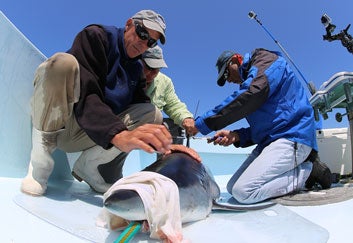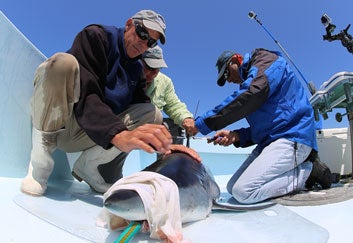 That’s why a University of Rhode Island shark expert joined colleagues at Nova Southeastern University’s Guy Harvey Research Institute and the Guy Harvey Ocean Foundation in establishing the Great Shark Race, an effort to draw attention to the plight of mako sharks while tracking the movements of the animals throughout the Atlantic. They encouraged businesses and individuals to sponsor sharks through the purchase of satellite tracking tags, which enabled the researchers to gather information about the sharks while also allowing the public to follow the tagged sharks online.
That’s why a University of Rhode Island shark expert joined colleagues at Nova Southeastern University’s Guy Harvey Research Institute and the Guy Harvey Ocean Foundation in establishing the Great Shark Race, an effort to draw attention to the plight of mako sharks while tracking the movements of the animals throughout the Atlantic. They encouraged businesses and individuals to sponsor sharks through the purchase of satellite tracking tags, which enabled the researchers to gather information about the sharks while also allowing the public to follow the tagged sharks online.
“There is little information available about mako shark populations, and because they experience a lot of fishing pressure, we wanted to demonstrate where they go and what habitats are most important to them,” said URI biologist Brad Wetherbee. “They’re also a fish without a country. Since they spend time in the waters of many different countries, the responsibility of managing or protecting them lies with many countries.”
The mako shark’s reputation for speed is what triggered the idea for the Great Shark Race, which awarded a prize to the sponsor of the shark that covered the greatest distance in six months. Wetherbee tagged 11 sharks off Ocean City, Md., last May, his colleagues found sponsors for each of the sharks, and in December a winner was declared.
The winner, a shark dubbed Ebenezer by its sponsor, entrepreneur Richard Branson, traveled more than 7,000 miles during the race, departing the Maryland coast for the Canadian Maritimes, then racing straight to South America before turning around and coming back.
“We weren’t expecting moves like that,” Wetherbee said. “Makos typically spend a lot of time off the mid-Atlantic States, where they feed on some rich food source, and then some swim to Nova Scotia and Newfoundland and feed there until fall or winter. They don’t typically stop much in between. Or that’s what we thought. We’re finding more and more exceptions to that rule.”
Sadly, three of the tagged sharks in the Great Shark Race were caught and killed by fishermen before the race was over. In fact, Ebenezer took the lead in the race after the shark previously in first place, Bregardo, was killed by a commercial fishing boat off the coast of Spain.
“In all of our previous research, we’ve never had any of our tagged sharks captured and killed by fishermen. It’s a huge ocean so you wouldn’t expect many of our tagged sharks to be captured,” Wetherbee said. “So the race has identified and highlighted this striking interaction between fishermen and mako sharks.”
In Canada, the sharks feed in an area where commercial fishermen use longlines to capture tuna and swordfish, and the fishermen often catch sharks as well. Along the East Coast, the sharks are primarily caught by recreational fishermen.
“The sharks tend to go to these places where there are a lot of fishermen, and when you’re the most popular fish out there, everybody is excited when they catch you,” Wetherbee said. “Other sharks they might release, but the fishermen keep makos.”
Wetherbee is looking forward to planning for the next edition of the Great Shark Race, which may include a division for oceanic white-tipped sharks, another declining species. He plans to capture and tag oceanic white-tips in April and mako sharks in May.
Click here for more information about the Great Shark Race.
Pictured caption: URI shark expert Brad Wetherbee (center) and colleagues from Nova Southeastern University tag a mako shark as part of the Great Shark Race. Photo by George Schellenger

